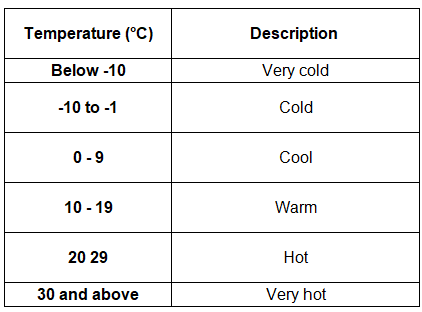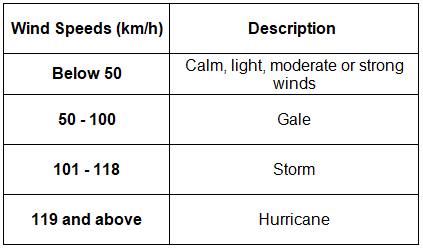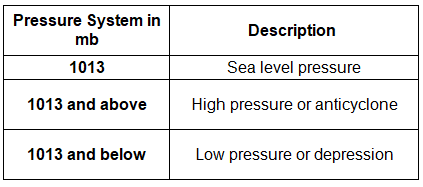Class 10 Exam > Class 10 Notes > Geography for GCSE/IGCSE > Weather Data
Weather Data | Geography for GCSE/IGCSE - Class 10 PDF Download
Calculations using Weather Data
Rainfall
- Rainfall totals are recorded daily, weekly, monthly, and annually.
- Measurement is standardized in millimeters (mm).
- Data is typically visualized on a bar graph.
- Mean monthly and annual rainfall averages are calculated over at least 30 years.
Describing Annual Rainfall Amounts:
Temperature
- Measured in °C or °F
- Always plotted as a line graph
- Calculations are:
- Diurnal (daily)
- Mean daily temperature
- Mean monthly temperature
- Annual range
- Mean annual range
Describing Temperatures: Describing Temperature Ranges:
Describing Temperature Ranges:
Wind
- Temperature is measured in different units like Knots (Kts), Miles per hour (mph), and Kilometres per hour (km/h).
- Wind direction is indicated from where it is coming using compass points, providing insights into temperature and moisture levels.
- The prevailing wind, like the southwest wind in the UK, is the most common wind direction in a region.
- The dominant wind signifies the strongest wind direction in an area.
- Wind barbs are used to plot wind speed and direction on a map.
Describing Wind Speeds:

Pressure
- Pressure is typically measured in millibars (mb) in relation to the average sea level pressure.
- The mean (average) sea level pressure is commonly at 1013mb.
- Pressure readings are time-dependent, varying based on specific circumstances:
- Following a storm or potential storm, frequent pressure readings, sometimes hourly, are necessary.
- Weekend forecasts generally entail daily pressure measurements.
- For sailing forecasts, an initial morning reading may be required, followed by subsequent updates.
- Isobars on weather charts connect areas with equal sea-level pressures:
- These isobars help identify atmospheric features like anticyclones (high pressure areas) and depressions (low pressure areas).
- Characteristics of high-pressure systems (anticyclones):
- Winds in high-pressure areas are usually gentle and flow clockwise (in the northern hemisphere).
- The descending air suppresses cloud formation, resulting in light winds and stable weather conditions.
- Features of low-pressure systems (depressions):
- Air in low-pressure areas ascends and moves counterclockwise around the center (in the northern hemisphere).
- As the rising air cools, water vapor condenses to form clouds and possibly precipitation.
- Depressions often bring unsettled weather with associated weather fronts.
- High-pressure systems are termed as such even if they do not reach 1013mb, surrounded by lower pressures.
- Conversely, low-pressure areas can have central pressure exceeding 1013mb, enclosed by higher pressures.
Describing Pressure Systems:
Relative Humidity
Relative humidity is a measure of the moisture content in the air in relation to the maximum amount of moisture that air can hold at a specific temperature.
- It is determined by observing where the depression of the wet bulb thermometer intersects with the dry bulb temperature line.
- Humidity is expressed as a percentage of the air's temperature.
- Temperature influences relative humidity; warmer air can hold more water vapor.
- For instance, at 20°C, air holding 4 grams of water has a relative humidity of 27%. If more water is added, the humidity increases until saturation is reached.
- When the temperature rises, air can hold more water, causing relative humidity to decrease. Conversely, as temperatures drop, excess water is released until equilibrium is achieved.
Question for Weather DataTry yourself: What is the unit of measurement for rainfall?View Solution
The document Weather Data | Geography for GCSE/IGCSE - Class 10 is a part of the Class 10 Course Geography for GCSE/IGCSE.
All you need of Class 10 at this link: Class 10
|
55 videos|68 docs|78 tests
|
FAQs on Weather Data - Geography for GCSE/IGCSE - Class 10
| 1. What is the relationship between pressure and relative humidity in weather data calculations? |  |
Ans. Pressure and relative humidity have an inverse relationship in weather data calculations. As pressure increases, relative humidity decreases, and vice versa.
| 2. How does pressure affect weather conditions? |  |
Ans. Pressure plays a significant role in determining weather conditions. High pressure usually brings clear skies and stable weather, while low pressure typically results in cloudy, rainy, or stormy conditions.
| 3. Why is it important to consider both pressure and relative humidity in weather data analysis? |  |
Ans. Both pressure and relative humidity provide valuable information about the current and future weather conditions. By analyzing both factors, meteorologists can make more accurate forecasts and predictions.
| 4. How can changes in pressure and relative humidity impact daily weather patterns? |  |
Ans. Changes in pressure and relative humidity can lead to shifts in weather patterns. For example, a decrease in pressure combined with high relative humidity may indicate the approach of a storm or precipitation.
| 5. What units are typically used to measure pressure and relative humidity in weather data calculations? |  |
Ans. Pressure is often measured in millibars or inches of mercury, while relative humidity is expressed as a percentage. These units are commonly used in weather data analysis and forecasting.
Related Searches




















